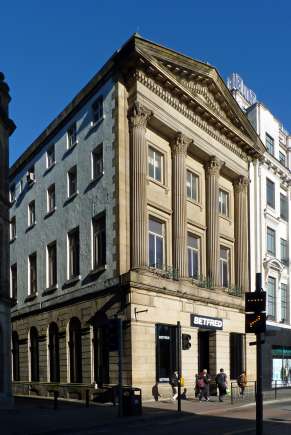Manchester & Salford Bank 10 Mosley Street Manchester
THE MANCHESTER AND SALFORD BANK - This building occupies a plot of ground on the north side of Mosley Street, at the corner with Marble Street, the front part only being devoted to the purpose of the bank, and the back occupied by a substantial and excellent warehouse. The principal facade presents a frontage to Mosley Street of about thirty-nine feet, and consists of a rusticated basement, of somewhat massive character, upon which are placed four very beautiful attached fluted Corinthian columns, three feet in diameter, supporting an entablature, surmounted by a pediment. The proportions of the classical model (that of the Temple of Jupiter Stator at Rome) have been strictly adhered to; the carving of the foliage of the capitals and other parts has been very beautifully executed; and although the greater part of the elaborate enrichments of the original have been very necessarily omitted, sufficient have been retained to render the effect both chaste and elegant. The door and windows at the basement have plain arched heads, and the two ranges of windows between the columns are finished with neat and appropriate dressings; those to the first floor have also balconies resting on the flat band, upon which the columns are placed. The public room of the bank is wainscotted throughout with Dantzic oak, the four sides being divided into compartments by pilasters supporting an entablature extending round the room; which latter is enriched with bronzed consoles, paterae, and lions’ heads. The natural beauty of the wood has been left to supply the place of number and richness in the mouldings, being only here and there slightly relieved with an inlay of bronzed metal. This room has an enriched coffered ceiling, which has a light and elegant appearance, contrasted with the massive character of the walls; and altogether the effect is such as is peculiarly appropriate to a room used for this purpose. The cash counter, desks and fittings are also of oak with Spanish mahogany tops; the former inlaid with bronzed metal, and the whole are arranged with every regard to convenience and utility. All the external doors and windows of the bank on the ground floor are secured by the revolving iron shutters, now coming into use (patented by Bunnett and Corpe, of London); the latter as well as the lower range between the columns are glazed with large panes of glass, giving a dignity to the building unattainable by other means. The directors private entrance is in Marble Street, whence a stone staircase leads to the principal story on which is the board room, lighted by two large windows in the Mosley Street front. This room is finished very plain, and with few mouldings, it being intended eventually to decorate it in the style now so generally in use on the continent, and which is a revival of a common practice of the ancients, as exemplified in the splendid remains of Egypt and Greece, and more particularly in the domestic edifices of Herculaneum and Pompeii; and has been treated of in the “Transactions of the Institute of British Architects,” and several recent German and French publications, as the polychromy of architecture. The remainder of this floor and the whole of the next are occupied with apartments appropriated to the domestic purposes of the establishment; and on the upper floor the warehouse extends over the whole site of the building. The whole has been executed from the designs, and under the superintendence of R Tattersall Esq, of Manchester; the masonry work by Messrs Ibberson and Company; and the remainder of the works by Messrs Haywood and Courtis. - Manchester Courier. [Civil Engineer and Architect’s Journal Volume 1, page 235]
Reference Manchester Guardian 12 August 1837 page 1 - contracts*
Reference Manchester Guardian 19 August 1837 page 1 - contracts*
Reference Civil Engineer and Architect’s Journal Volume 1, Oct 1837-Dec 1838, page 235 – taken from the Manchester Courier
Reference Manchester Guardian 21 April 1838 page 3
